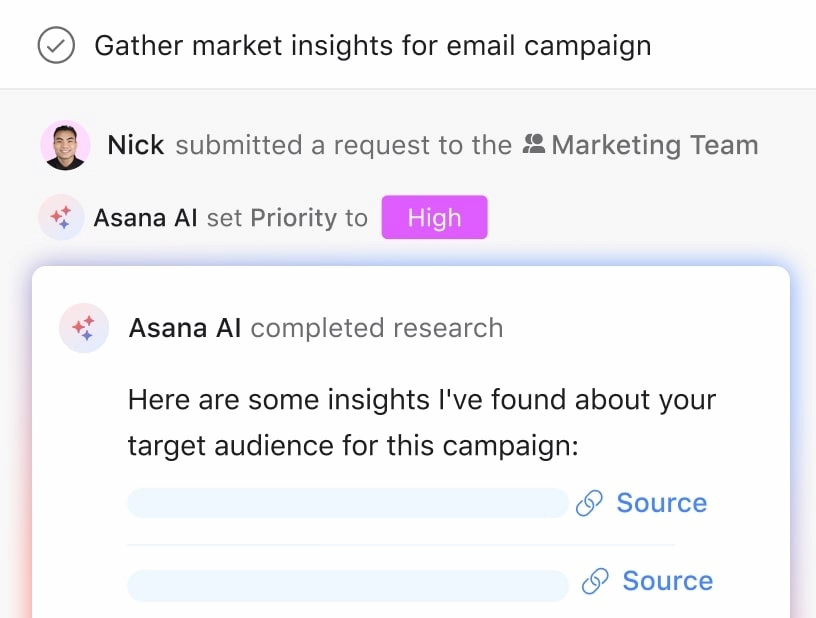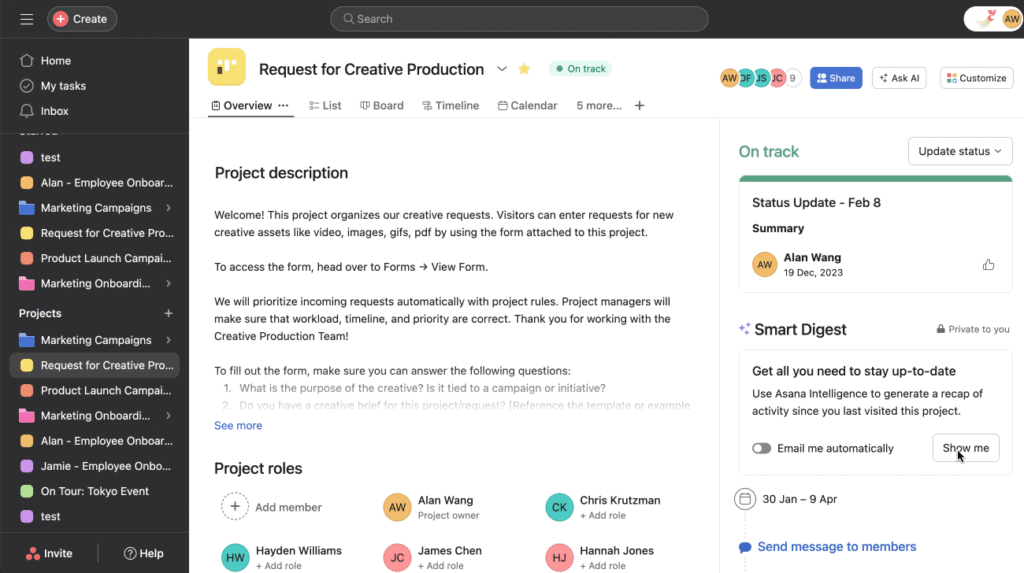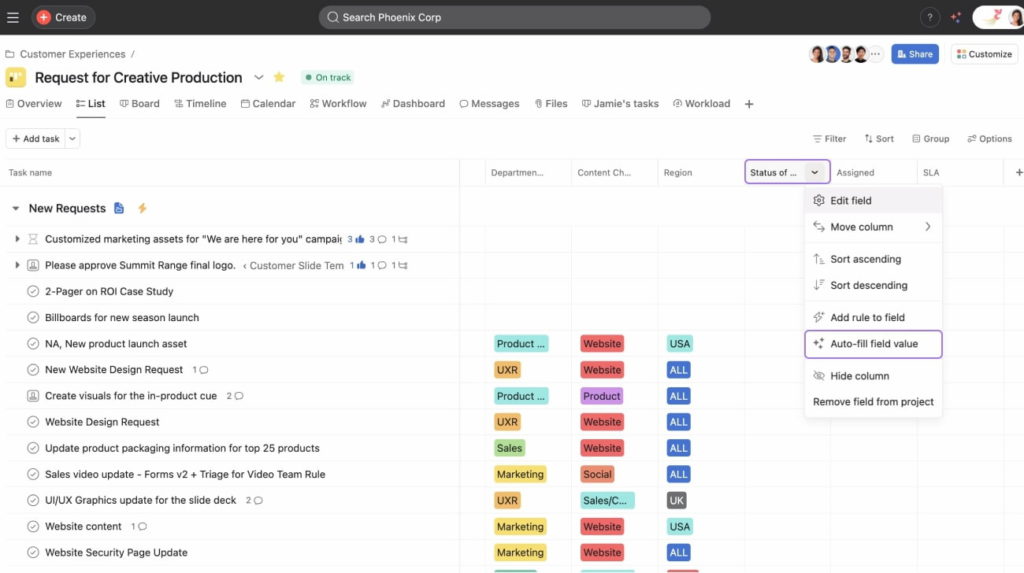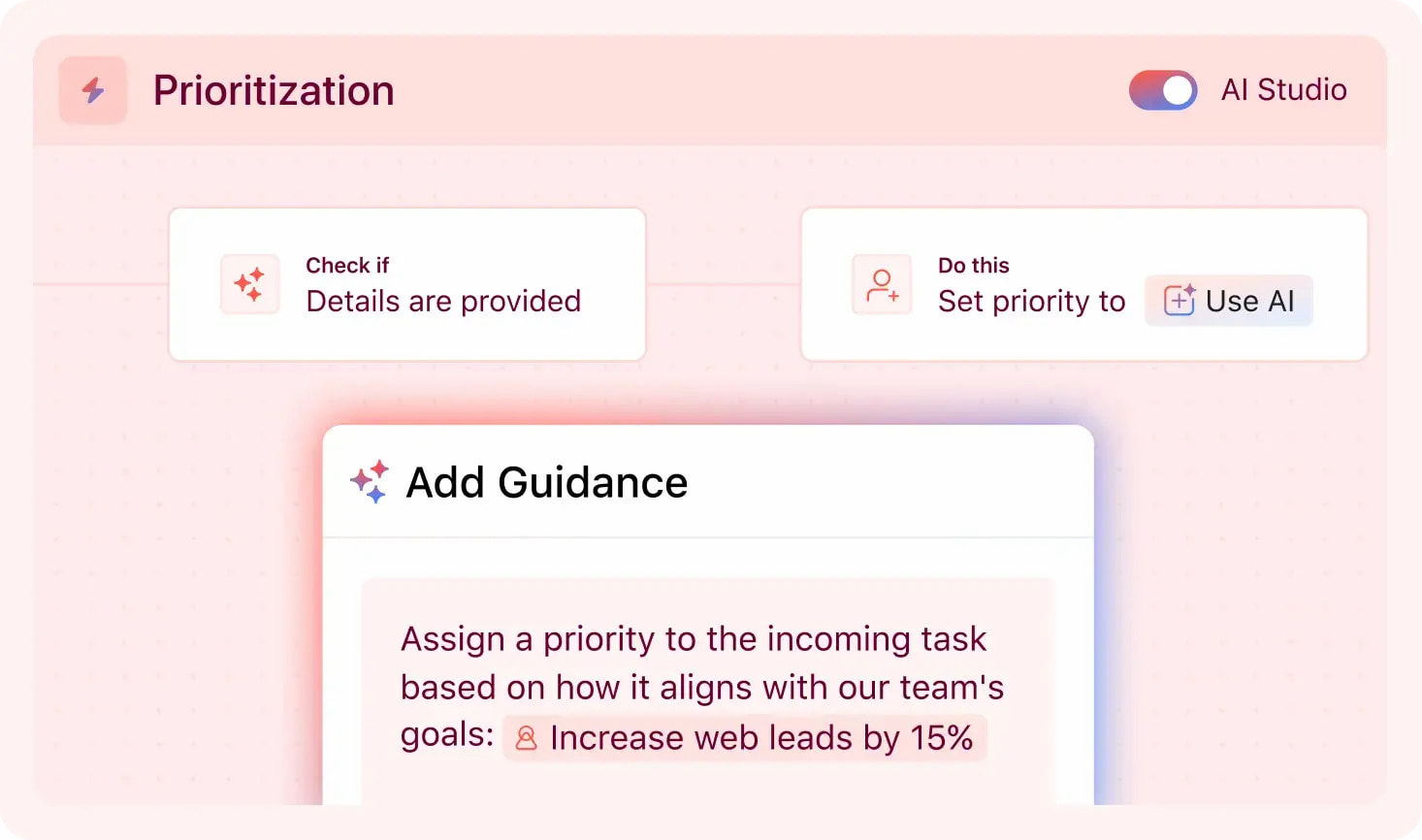Asana AI isn’t just another shiny add-on buried in your dashboard. It’s one of the more useful ways real AI shows up in everyday project management. If you’re juggling tasks, briefs, updates, and team chaos, it makes a huge difference.
This piece explains what Asana AI is, what it actually does, who should use it, and how it stacks up against other AI tools.
What is Asana AI?
Asana AI is a built-in set of features designed to reduce repetitive work, generate insights, and streamline collaboration. Unlike generic bots, it understands your actual projects, tasks, and workflows—bringing context-aware automation to your team.
Key features include:
- 📝 Smart summaries for tasks and meetings
- 💬 Natural language rule creation
- 🎯 Auto-generated goals and status updates
- 🏷️ Smart fields and tagging
- 🔍 AI-powered search and recommendations

New: Asana AI Studio — a no-code builder for creating custom AI workflows right inside Asana.
Real Use Cases: How Asana AI Actually Helps Teams
Let’s skip the hypotheticals. Here’s how real teams are already putting Asana AI to work.
1. ✍️ Project updates without writing a novel
Smart Summaries can auto-generate a clean, digestible status update based on recent activity, comments, and milestones — perfect when you’re juggling multiple stakeholders and zero time.

2. 🎯 Team alignment without micromanagement
AI-suggested Smart Goals help define OKRs from existing work. If you already have goals, it suggests alignment. If not, it builds from your current progress and scope.
3. 🧠 Automation through plain language
No more flowcharts. Just type rules like “reassign overdue tasks after 3 days” and let Smart Rule Creator handle the automation setup — no code, no logic trees.
4. 🏷️ AI-driven tagging and sorting
Smart Fields suggest labels based on project type, behavior, and historical data — so your task lists stay organized even when you don’t have time to clean them up manually.

What Is Asana AI Studio?
It’s the new kid on the block — think Zapier meets ChatGPT, but inside your Asana workspace.
Asana AI Studio is a no-code builder for creating custom AI agents, workflows, and automations. You can:
- 🤖 Train AI to follow your team’s internal workflows
- 🧾 Build forms that route requests and assign owners intelligently
- 🔎 Use natural language to search, query, or trigger actions
- 🔌 Connect with tools like OpenAI or Claude for deeper logic
Say your team runs monthly campaign planning — AI Studio can auto-create boards, assign tasks, set due dates, and ping contributors, based on last month’s format. No setup needed.
Check this introductory video to get acquainted with Asana AI more.
Pros and Cons (Real Ones)
✅ Pros
- Actually reduces manual work, especially in high-comms teams
- Natural language automation = faster onboarding
- No-code workflows that are actually useful
- Summaries and search save mental effort
- Goal and status suggestions are surprisingly accurate
❌ Cons
- AI is only as useful as your data quality
- Not great for completely unstructured workflows
- Limited integrations unless you connect third-party AI APIs
- Only available in paid tiers
Asana AI vs Traditional Automation Tools
| 🔍 Feature | Asana AI | Zapier / Make | Trello Butler / Monday.com |
|---|---|---|---|
| Natural language rules | Yes | No | No |
| Smart summaries | Built-in | Unavailable | Basic |
| Task + goal awareness | Integrated | Requires setup | Partial |
| No-code builder | AI Studio | Logic-based | Template-driven |
| Best for | Mid to large teams | Cross-platform flows | Visual planners |
Who Should Actually Use This
If your team fits one of these profiles, Asana will be useful if you:
- Manage more than 5 active projects at once
- Have multiple collaborators across teams
- Send out status updates weekly
- Track goals, OKRs, or KPIs
- Hate writing duplicate content or chasing down updates
If you’re a solo freelancer or only use Asana as a glorified to-do list, this might be overkill.
Everhour + Asana: Time Tracking That Feels Native
One gap in Asana AI is time tracking. That’s where Everhour comes in. It’s a time tracking tool that integrates directly into Asana so your team can:
- Log hours on tasks without leaving Asana via its Asana time tracking integration
- Set budget limits and get alerts
- Track billable vs. non-billable hours
- Create reports without spreadsheets
With AI setting the flow and Everhour capturing the time, you get a full picture: who did what, for how long, and whether it stayed on budget.
Here are some of Everhour’s user reviews:
“It is being used to track time on projects. It is integrated with Asana and is used to determine budgets and burn rates. It is used mostly by Onboarding and Client services to track individual initiatives.” [Josh, Trust Radius]
“As a remote-based company, we highly rely on task management tools such as Jira and Asana, and it’s critical to control and gain knowledge on how we spend our time, and that’s what is Everhour used for.
Since we use two different tools, Jira for the tech team and Asana for the management team, we found in Everhour a very practical way to concentrate reporting regardless of the task management tools every member of the team uses.” [Eduardo, Trust Radius]
“Everhour integrates perfectly into Asana, where we manage all of our work, and Xero, where we bill all of our clients and pay our contractors. No more using outside time tracking tools, copying and pasting task titles into the outside tool, and wondering which time entries apply to which tasks.” [Joel, G2]
FAQ
❓ Is Asana AI available in free plans?
No. Most AI features are only available in premium or enterprise tiers.
❓ Can Asana AI summarize tasks or meetings?
It can. Smart Summaries will auto-generate text based on task activity, comments, and status.
❓ Does Asana AI integrate with ChatGPT or other LLMs?
Asana allows you to connect external models via API, including OpenAI (check out the best ChatGPT prompts for project management).
❓ Can I create rules in Asana AI without code?
Type what you want, and Asana converts it into logic. Example: “Reassign task if overdue by 2 days.”
❓ What are examples of Asana AI workflows?
- Monthly sprint boards built from templates
- Auto-generated stakeholder updates every Friday
- Reassignments based on task inactivity
Final Thoughts
Asana AI isn’t magic. However, it’s one of the few AI implementations in SaaS that actually makes sense. It cuts waste without creating more tools to manage. And with features like AI Studio and native integration with tools like Everhour, it’s becoming one of the most complete AI-enabled project management ecosystems.
If you run projects and want clarity instead of chaos, it’s time to stop manually summarizing Slack threads and start automating the obvious.
If you’re using Asana to streamline task management, don’t forget to pair it with Everhour‘s time tracker. Together, they give you a powerful combo of smart planning and accurate reporting!
Make sure to check out other free AI tools for project management!

